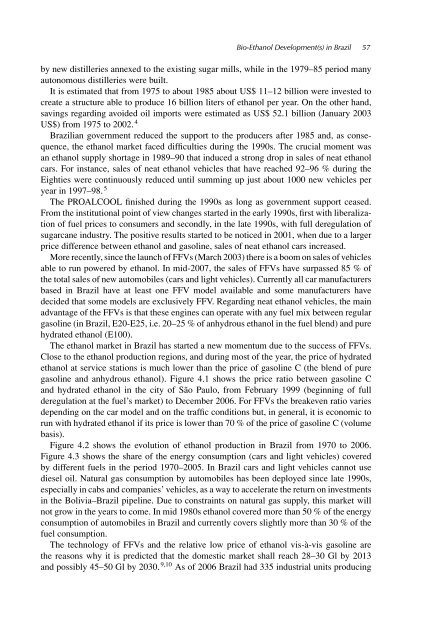Biofuels in Perspective
Biofuels in Perspective
Biofuels in Perspective
Create successful ePaper yourself
Turn your PDF publications into a flip-book with our unique Google optimized e-Paper software.
Bio-Ethanol Development(s) <strong>in</strong> Brazil 57<br />
by new distilleries annexed to the exist<strong>in</strong>g sugar mills, while <strong>in</strong> the 1979–85 period many<br />
autonomous distilleries were built.<br />
It is estimated that from 1975 to about 1985 about US$ 11–12 billion were <strong>in</strong>vested to<br />
create a structure able to produce 16 billion liters of ethanol per year. On the other hand,<br />
sav<strong>in</strong>gs regard<strong>in</strong>g avoided oil imports were estimated as US$ 52.1 billion (January 2003<br />
US$) from 1975 to 2002. 4<br />
Brazilian government reduced the support to the producers after 1985 and, as consequence,<br />
the ethanol market faced difficulties dur<strong>in</strong>g the 1990s. The crucial moment was<br />
an ethanol supply shortage <strong>in</strong> 1989–90 that <strong>in</strong>duced a strong drop <strong>in</strong> sales of neat ethanol<br />
cars. For <strong>in</strong>stance, sales of neat ethanol vehicles that have reached 92–96 % dur<strong>in</strong>g the<br />
Eighties were cont<strong>in</strong>uously reduced until summ<strong>in</strong>g up just about 1000 new vehicles per<br />
year <strong>in</strong> 1997–98. 5<br />
The PROALCOOL f<strong>in</strong>ished dur<strong>in</strong>g the 1990s as long as government support ceased.<br />
From the <strong>in</strong>stitutional po<strong>in</strong>t of view changes started <strong>in</strong> the early 1990s, first with liberalization<br />
of fuel prices to consumers and secondly, <strong>in</strong> the late 1990s, with full deregulation of<br />
sugarcane <strong>in</strong>dustry. The positive results started to be noticed <strong>in</strong> 2001, when due to a larger<br />
price difference between ethanol and gasol<strong>in</strong>e, sales of neat ethanol cars <strong>in</strong>creased.<br />
More recently, s<strong>in</strong>ce the launch of FFVs (March 2003) there is a boom on sales of vehicles<br />
able to run powered by ethanol. In mid-2007, the sales of FFVs have surpassed 85 % of<br />
the total sales of new automobiles (cars and light vehicles). Currently all car manufacturers<br />
based <strong>in</strong> Brazil have at least one FFV model available and some manufacturers have<br />
decided that some models are exclusively FFV. Regard<strong>in</strong>g neat ethanol vehicles, the ma<strong>in</strong><br />
advantage of the FFVs is that these eng<strong>in</strong>es can operate with any fuel mix between regular<br />
gasol<strong>in</strong>e (<strong>in</strong> Brazil, E20-E25, i.e. 20–25 % of anhydrous ethanol <strong>in</strong> the fuel blend) and pure<br />
hydrated ethanol (E100).<br />
The ethanol market <strong>in</strong> Brazil has started a new momentum due to the success of FFVs.<br />
Close to the ethanol production regions, and dur<strong>in</strong>g most of the year, the price of hydrated<br />
ethanol at service stations is much lower than the price of gasol<strong>in</strong>e C (the blend of pure<br />
gasol<strong>in</strong>e and anhydrous ethanol). Figure 4.1 shows the price ratio between gasol<strong>in</strong>e C<br />
and hydrated ethanol <strong>in</strong> the city of São Paulo, from February 1999 (beg<strong>in</strong>n<strong>in</strong>g of full<br />
deregulation at the fuel’s market) to December 2006. For FFVs the breakeven ratio varies<br />
depend<strong>in</strong>g on the car model and on the traffic conditions but, <strong>in</strong> general, it is economic to<br />
run with hydrated ethanol if its price is lower than 70 % of the price of gasol<strong>in</strong>e C (volume<br />
basis).<br />
Figure 4.2 shows the evolution of ethanol production <strong>in</strong> Brazil from 1970 to 2006.<br />
Figure 4.3 shows the share of the energy consumption (cars and light vehicles) covered<br />
by different fuels <strong>in</strong> the period 1970–2005. In Brazil cars and light vehicles cannot use<br />
diesel oil. Natural gas consumption by automobiles has been deployed s<strong>in</strong>ce late 1990s,<br />
especially <strong>in</strong> cabs and companies’ vehicles, as a way to accelerate the return on <strong>in</strong>vestments<br />
<strong>in</strong> the Bolivia–Brazil pipel<strong>in</strong>e. Due to constra<strong>in</strong>ts on natural gas supply, this market will<br />
not grow <strong>in</strong> the years to come. In mid 1980s ethanol covered more than 50 % of the energy<br />
consumption of automobiles <strong>in</strong> Brazil and currently covers slightly more than 30 % of the<br />
fuel consumption.<br />
The technology of FFVs and the relative low price of ethanol vis-à-vis gasol<strong>in</strong>e are<br />
the reasons why it is predicted that the domestic market shall reach 28–30 Gl by 2013<br />
and possibly 45–50 Gl by 2030. 9,10 As of 2006 Brazil had 335 <strong>in</strong>dustrial units produc<strong>in</strong>g








